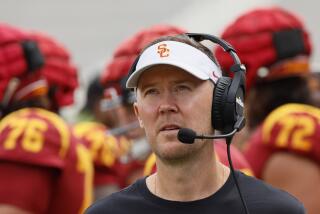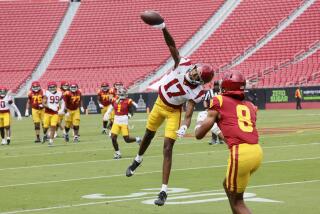Smith Tells Royster: Less Talk, More Gains
- Share via
At halftime of USC’s 30-14 victory over Oregon two weeks ago, Coach Larry Smith issued a challenge to tailback Mazio Royster:
Knock down some Ducks.
Royster responded by rushing for 111 yards and two touchdowns in 21 second-half carries.
Sparked by Royster, the Trojans scored 24 consecutive points to break a 6-6 halftime tie.
Afterward, Royster said it was about time that Smith had given him the ball.
All told, Royster carried 29 times against the Ducks, rushing for a season-high 132 yards.
It was almost twice as many carries as he had made the previous week in a 32-25 loss to Arizona State, when he split time with Deon Strother, and Royster made it clear that he was more than happy to shoulder the load.
Alternating with Strother, he said, was “an insult” to his ability, which proved considerable last season, when he joined Charles White and Anthony Davis as the only Trojans to rush for more than 1,000 yards as sophomores.
“To me, the great Trojan tailbacks of the past got the ball and they were Superman,” Royster said. “That’s the idea I got from Charles White, Marcus Allen.
“There was no alternating. John Robinson didn’t (have) Marcus Allen split time. He gave him the ball all the time. That’s how I want it to be. I want to help out the team every way I can, and if I’m not in there, I don’t think the play’s being run to its full capability.”
His comments led Tuesday to another challenge from his coach:
Shut up.
“Maybe he ought to move up to the press box and call the plays,” Smith said testily in response to a query. “Next question.”
But what about Royster’s contention that the more he carries the ball, the more he will develop a feel for the game, making him that much more productive?
“I think a runner should take what the coaches call for him and be happy,” Smith said. “That’s what I think. We call the plays, and whichever back’s running well, he’s going to get the ball.”
Smith said it is too demanding to carry the ball 30 times a game, which might come as a surprise to former USC coach John McKay, who argued that he wasn’t overworking his tailbacks by having them carry so much, because the ball wasn’t very heavy.
In the second half against Oregon, Royster evoked memories of last season, when he ran for more than 100 yards in six of his nine starts after replacing Ricky Ervins as the Trojans’ No. 1 tailback in the fifth week of the season.
“He started running over people, making people miss,” Smith said.
Still, Smith wants more.
“A great back, to me, has got to make some big, long plays,” Smith said. “We’re getting him a lot of yards just on (the strength of) his offensive line. . . .
“It’s time he turned it on.”
Royster’s longest run last year was 50 yards, as a reserve late in the fourth game of the season, a 35-26 victory over Ohio State.
As a starter, he had no run longer than 21 yards. His longest this season has been for 19 yards.
“I told him, for every 20 carries he gets, we’ve got to start getting some big plays,” Smith said. “I’m not questioning how he’s playing or anything--he’s got a tremendous attitude in practice--but when he gets into a game, it’s time to turn a corner.”
Royster started well this season, running for 97 yards in the first half of the season-opening loss to Memphis State. But a sprained knee kept him out of the second half, and he didn’t dress for USC’s upset victory over Penn State.
He returned to run for 78 yards in 16 carries against Arizona State.
“I think the injury definitely slowed him up a bit,” Smith said.
Now that Royster has recovered, Smith wants more game-breaking runs.
And less popping off.
More to Read
Fight on! Are you a true Trojans fan?
Get our Times of Troy newsletter for USC insights, news and much more.
You may occasionally receive promotional content from the Los Angeles Times.






